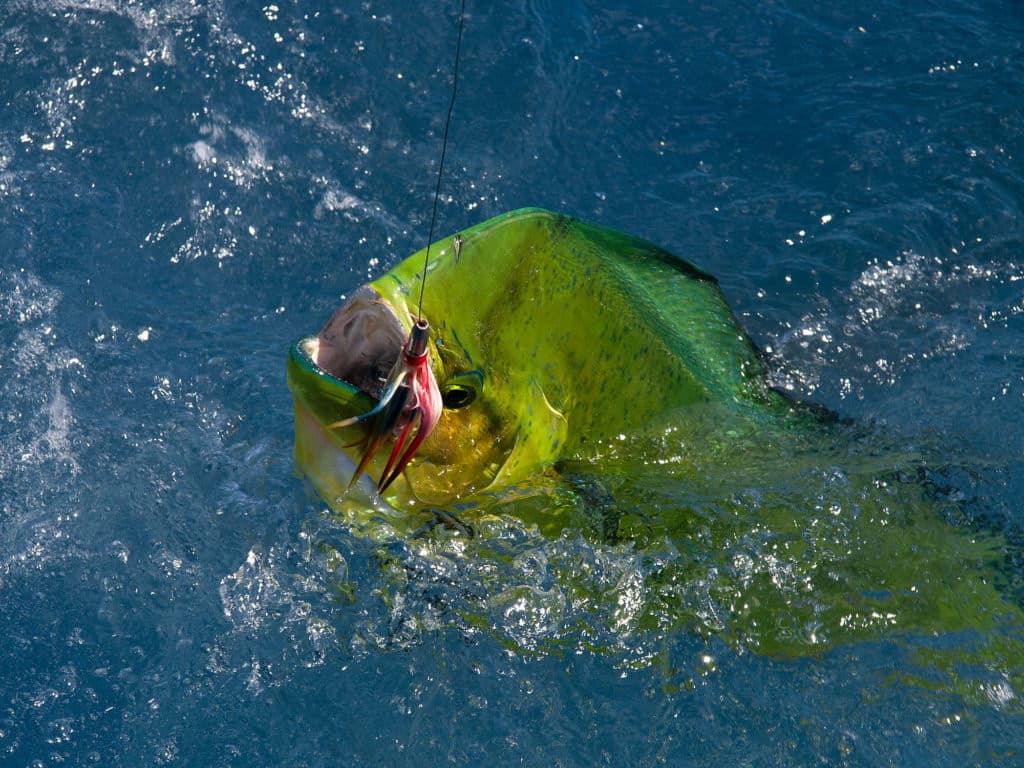
Thirty miles off Oregon Inlet, North Carolina, trolling down a weed line in a 50-foot sportfish, we ambushed a pack of big dolphin. The fish attacked our spread, leaping out of the water, slashing behind a skipping bait, greyhounding from one side of the spread to the other.
With outrigger pins popping, rods bending over and lines coming tight, mate William Howell called anglers out of the cabin while Capt. Jason Snead put the teal-green Dream Girl into a tight turn.
Once all the rods were heaving with big fish and the reels losing line, Howell instructed the anglers to grab a gimbal belt and a fishing rod. Snead kept the boat idling forward while the anglers worked their fish to the boat.
Big dolphin don’t come easy. The broad green-and-blue fish streaked side to side and leaped into the air, frantic to escape. The anglers labored over their reels while captain and mate orchestrated a line dance with anglers shuffling around the cockpit to stay untangled.
In short order, Howell handlined each mahi close to the boat, gaffing it and swinging it into the fish box. As the anglers shared high-fives and back slaps, Howell deployed the lines and Snead bumped the boat back to trolling speed. Dream Girl lurched and rolled over waves and troughs and all eyes searched the sea to find the next weed line.
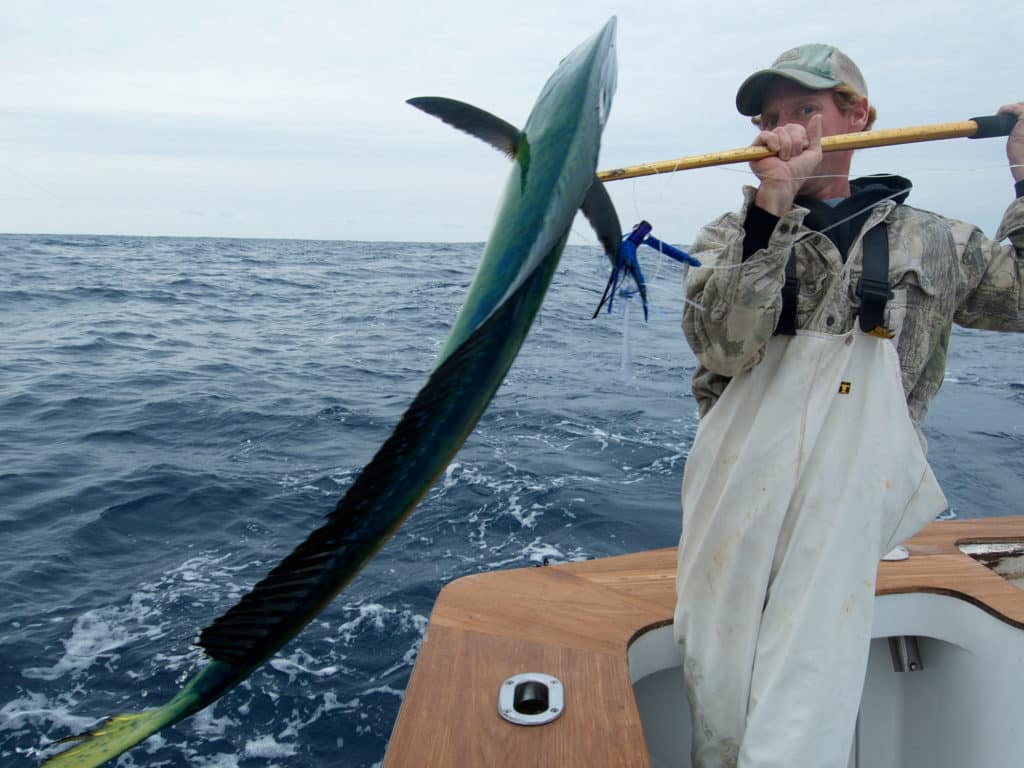
Dolphin Season
This scene played out a few years ago. Today, Howell runs his own boat, Drifter. I caught up with him in late spring as he prepared for another season of dolphin fishing.
Howell expects bigger fish to show up off Oregon Inlet in April and hang out all summer. From mid-summer to early fall, the bulls move north. Between June and September, anglers from Virginia to New Jersey see their best big-dolphin action.
At least that’s how it’s supposed to go. The last few years, anglers have seen fewer big dolphin in early summer. So, when the sargassum weed lines up and the dolphin are on the feed, anglers need to be ready to make the most of the opportunity.
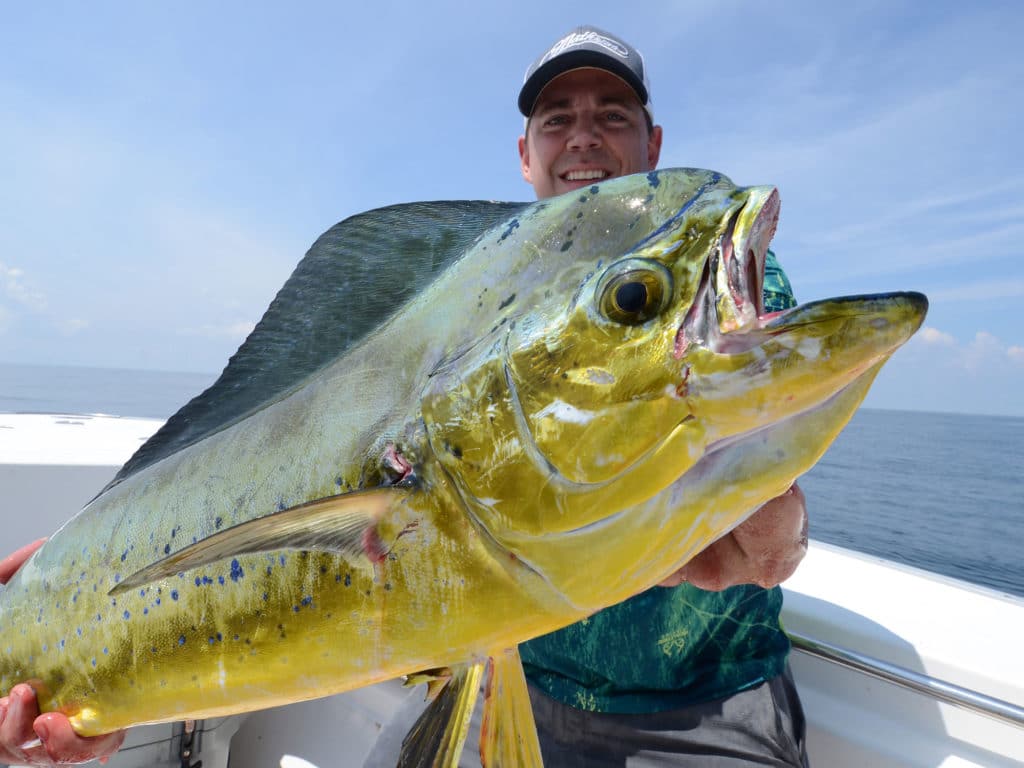
Finding Mahi
Howell generally hunts dolphin from 20 fathoms to the edge of the continental shelf. But to find big fish, Howell depends on sea-surface-temperature charts. “Water temperature is more important than depth,” he says. He looks for a substantial change in water temperature and color.
Once the boat crosses the change, Howell searches for floating sargassum that serves as a dolphin oasis. According to Howell, ideal conditions include a southwest wind blowing the weed against the edge of the Gulf Stream current.
Farther up the coast, anglers fishing off mid-Atlantic states don’t have the reliable Gulf Stream current found off Hatteras. Instead, they look for less significant changes in water temperature, clarity, altimetry and plankton levels that help amass sargassum and floating flotsam, which hold dolphin.
Once Howell finds the weed line, he slows the boat to 6 knots and puts out four rods. “I keep the spread limited to four rods to reduce tangles and keep the fish focused,” he says.
Big dolphin play like puppies in a dog park. Fewer baits in the water keep the dolphin on target and improve the chances for a good bite. If a dolphin hits a lure and misses, though, pull the ravaged hook out of the water and drop a fresh bait back.
Rigging a naked, unweighted skipping ballyhoo takes just a few minutes. In this video, the author walks you through the basic procedure.
Tackle and Rigging
Howell targets bulls with a quiver of 20-pound trolling rods paired with lever-drag reels spooled with 30-pound monofilament. To the end of the line, he ties a Bimini-to-no-name-knot connection to attach a 24-foot length of 80-pound mono and ties a 250-pound snap swivel to the end. For the leader, he ties a surgeon’s loop at the end of a 5-foot piece of 50-pound monofilament and terminates that with a 7/0, short-shank, thin-wire J-hook. Slip the surgeon’s loop into the snap swivel to complete the rig.
To add the bait, select a small ballyhoo, thaw it in saltwater and remove the eyes. Squeeze the bait and break its back. Take a 12-inch piece of copper rigging wire and thread one inch of it through the hook eye. Wrap that short end around the hook shank, leaving the remaining 11 inches of wire as a long tag end.
Hold the ballyhoo upside down and insert the point of the hook into the base of the gills. Thread the ballyhoo onto the hook as if threading a soft-plastic artificial onto a jig head. The point of the hook exits the belly and the eye of the hook rides beneath the ballyhoo’s eye.
Pass the long tag end of the rigging wire through the ballyhoo’s eye socket two times. Push the tip of the wire up through the base of the ballyhoo’s bill and then wrap the wire around 1/2 inch of the bill. Break off the remainder of the bill.
Howell rigs some of the ballyhoo with a chin weight so that they slightly submerge, but he prefers to skip unweighted baits along the surface.
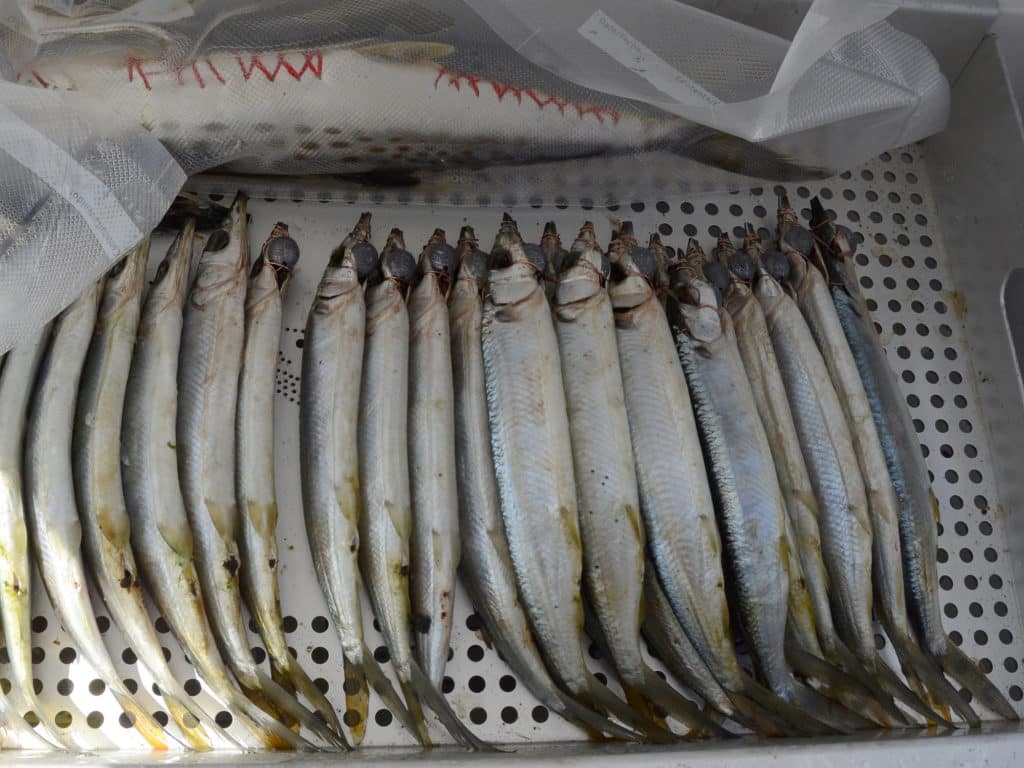
Captain’s Tips
To deploy his four baits, he uses a mix of short rigger, long rigger and flat line positions. He keeps four more rods rigged and ready to pitch to dolphin in the spread. “I wouldn’t want more than six dolphin on at once,” he laughs, imagining the chaos that would create.
He lets the baits drop back in the spread until they skip across the water or swim just below the surface without spending more than a few seconds in the water or in the air.
When a school of dolphin attacks, Howell keeps the boat trolling until all rods host fish. If a dolphin strikes short, he picks up the rod and jerks it, then drops the rod tip to make what’s left of the bait shoot across the water and sink back to the fish. If that doesn’t elicit another bite, he instructs the angler to pull in the bait while another angler drops a fresh ballyhoo into the spread.
Once a fish is hooked, he keeps the boat moving slowly ahead while the angler reels. “The key is to keep the fish behind the boat and the lines untangled,” he says.
When the fish is within 20 feet of the boat, Howell sets the 6-foot gaff in reach and lightly takes the line in his hands. Carefully, he guides the fish by holding the line low to the water to keep the fish’s head submerged. If the dolphin gets its head above water, it jumps into the air and most likely throws the hook.
Read Next: Mahi Fishing Tips
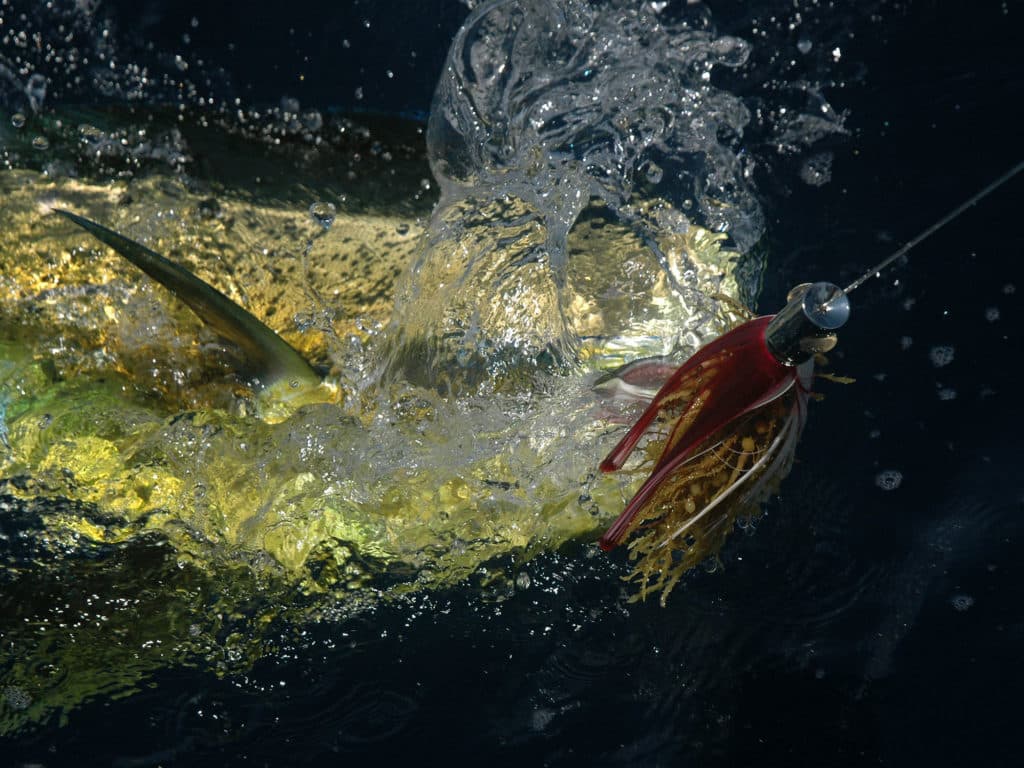
Once the dolphin is gaffable, Howell strokes it in the back just behind the head. Then, in one motion, he lifts the fish out of the water and swings it into the fish box — where it often explodes in a frenzy of tail whipping, rod-breaking energy.
When big dolphin school up behind the boat, or Howell finds a pack of fish on a float, he slows the boat and drops a rigged ballyhoo to the dolphin. He jigs the bait back and forth to get the fish’s attention. When he fires up a feeding frenzy, Howell can catch big dolphin one after another. “Dolphin fishing is one of the coolest things we get to do,” he says. Fast action, aggressive fish and an explosive fight make dolphin a fan favorite. “People love to catch them.”








